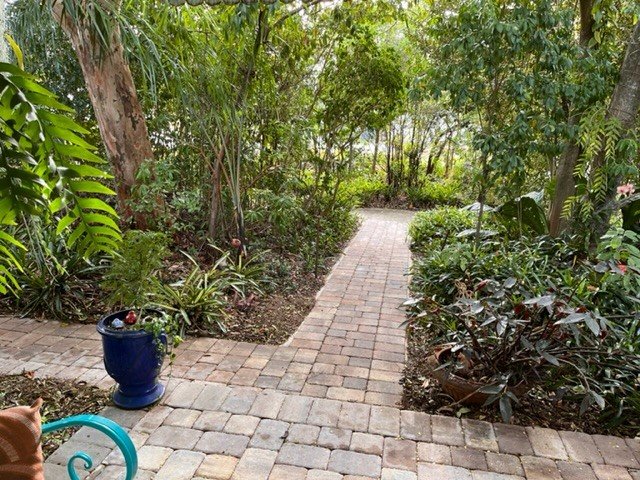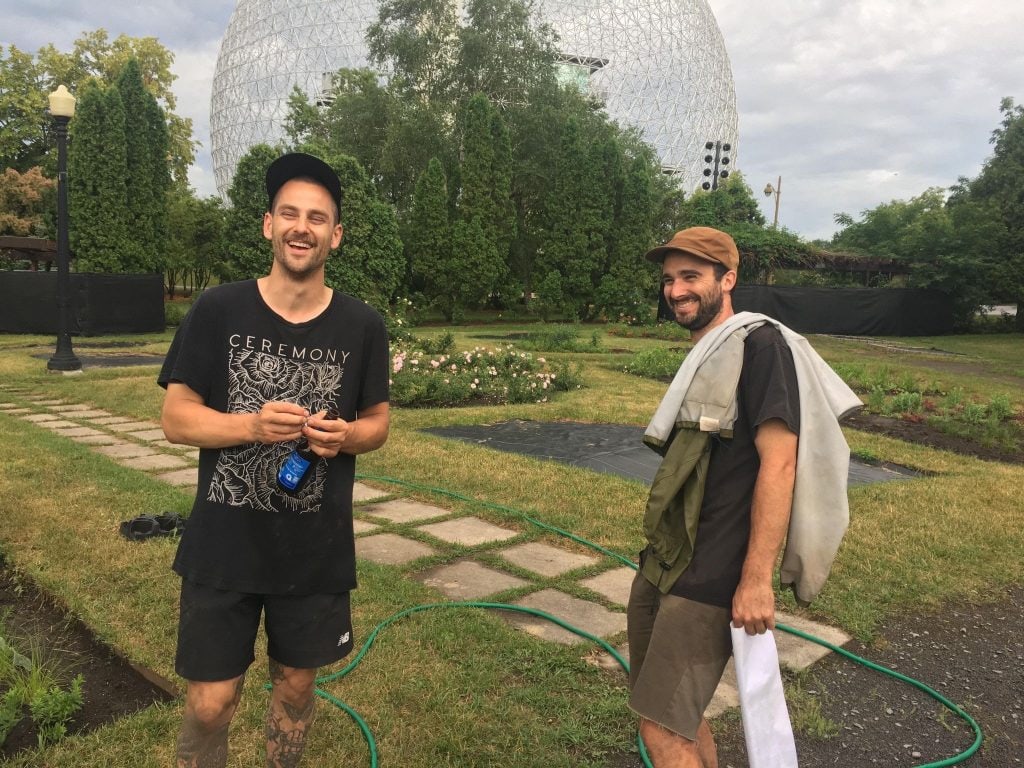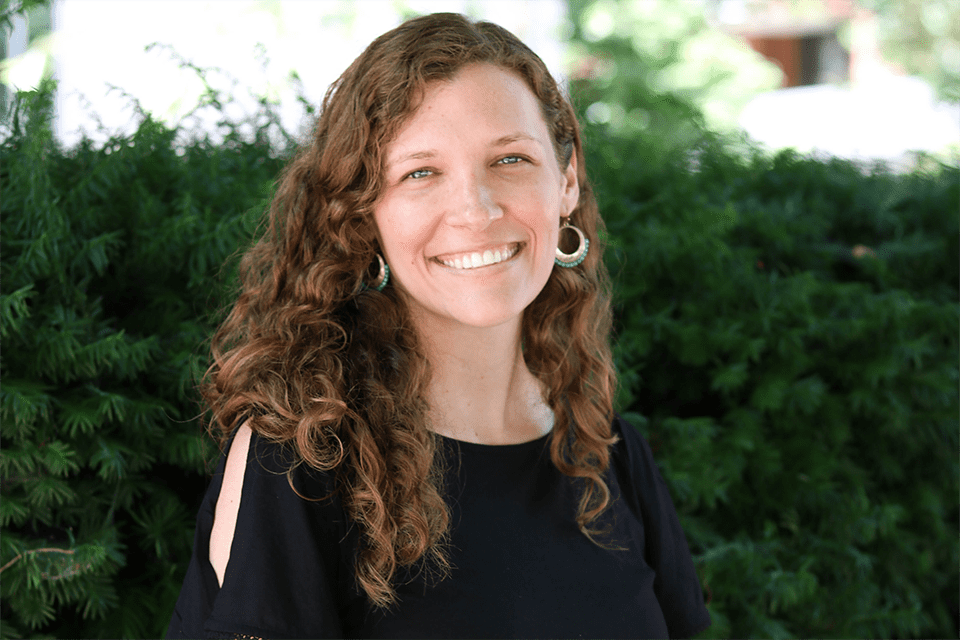When Donna Corbelli Castro moved to her home in South Florida 25 years ago, her yard was “stark, barren, hot and devoid of any trees,” she says. The typical way to tackle this would have been to do what many of her neighbors had done: lay down a tidy, manicured lawn, perhaps with a couple of little bushes or decorative plants.
But as a horticulturist, Castro had a different vision: a yard brimming with native trees and shrubs. She promptly set about creating a “mini forest” in front of her house. Today, there is virtually no lawn space in Castro’s yard. Instead, it’s a gorgeous homegrown wildlife sanctuary that attracts and nourishes a wide range of local pollinators.

“The trees make a canopy over our patio and yard, the air is fresh and fragrant, and wildlife abounds,” she says. “Although I live near a fairly busy street, and have neighbors on every side, you feel like you are in another world. The butterflies are too numerous to count at times. The birds are building nests and feasting off the bounty of the native trees and shrubs, and the bees are always buzzing, happily collecting nectar and pollen.”
Nouveaux Voisins — New Neighbors, in English — envisions a world of yards like this, where suburban landscapes teem with life and buzz with planet-nourishing biodiversity. The Montreal-based nonprofit aims to “transform the culture of lawns” by educating people about how they can turn their yards (or balconies, or window ledges) into critical habitats for native plants and pollinators.
A glimpse of this world can be seen in its series of “showcase gardens” in Montreal’s Jean Drapeau Park, a sampler of aesthetically pleasing, biodiversity-rich yard types. There’s a variety to choose from, as different yards mimic different natural habitats: dry meadow, open woods, lowland garden, shady forest glade. Taken together, they represent a range of gardening aesthetics, from “pretty wild” to “semi-lawn.” The idea is to offer visible proof that a native yard can be beautiful, too, and that there are options to match anyone’s taste.
What we do with our yards matters, in part because they’ve become such a dominant part of our world. Residential yards make up more than 16 percent of all land in the contiguous United States, and are rapidly expanding. Most of these are simple turfgrass, which is now the nation’s largest irrigated crop. Yet these lawns are ecologically inert — many scientists refer to them as “biodiversity deserts.”
“Simplifying the landscape so that we just have one or two trees and turfgrass takes away plant diversity, it takes away structural diversity, it takes away habitat that wildlife [use to] live, feed and raise their young,” says Desirée Narango, an ecologist and researcher at the University of Massachusetts, Amherst. “All of those important resources are lost.”
“In many cases,” she adds, “we have taken away the native vegetation and replaced it with nonnative or exotic vegetation that — in many to most cases — our wildlife has not adapted to use.”
Narango was the lead author of a 2018 Smithsonian Institute study that found that using nonnative trees and shrubs in residential yards can lead to declines in native bird species. She and her colleagues found that suburban Maryland yards with nonnative plants were less likely to have breeding Carolina chickadees, and those chickadees fledged fewer young, because the nonnative plants didn’t support insects that the chickadee feeds on. The only yards that were able to sustain a stable population of chickadees were those that contained more than 70 percent native plants, the study found.
“There are a lot of folks who think the only reason they have birds in their backyard is because they have feeders, but in reality it’s the amount of insect biodiversity that’s supporting the birds,” says Narango. “If we can help people make that connection that the more insects you support, the more songbirds you’re going to have … that would be a huge step.”

A basic principle to stick to in wildlife-friendly gardening is to be inspired by nature, says Emile Forest, chief coordinator and gardener for Nouveaux Voisins. This is the approach Nouveaux Voisins takes with its showcase gardens. Each contains four to eight plant varieties that are found in natural environments like woodlands, meadows or prairies. A garden representing prairie conditions, for example, features airy clusters of tufted hairgrass and clumps of wild thyme, which blooms bright purple. Another garden inspired by meadows and open woodland contains tall pink and purple coneflowers, irresistible to butterflies and bees.
“With cuisine, chefs often say ‘If it grows together, it goes together,’” says Forest. “It’s the same in natural planting. If it grows together it’s going to look good in a garden, but you can rearrange it in a way that is more organized and orderly.”
The showcase gardens recognize that the human environment is nearly as diverse as nature itself. For urbanites, for example, Forest and his team have designed gardens well-suited to busy roadsides, featuring native plants that can thrive in depleted soil, such as the bright-yellow butterfly flower and the ethereal prairie dropseed. For those whose yards get little sun, they’ve designed gardens with shade-loving plants like the delicate dwarf-crested iris. Gardeners who are busy (or lazy) are pointed toward easy-to-maintain groundcover varietals like wild strawberry. This removes the guesswork for new converts: Forest says he wants visitors to be able to “copy-paste” these gardens into their own yards if they choose.
But copying and pasting a natural yard requires access to the local flora — which, ironically, is often hard to find locally.
“Native plant availability is not where it should be,” says Narango. “It needs to be more widely available, it needs to be more affordable, it needs to be in places like Home Depot and Wal-Mart.”
The great majority of plants sold by garden centers and nurseries are nonnative, though smaller, independently-owned nurseries tend to offer a greater selection of native plants than big retailers, says Narango. Even when these stores do carry native plants, they’re often not clearly marked as such, making it difficult for consumers to make smarter choices for the environment.
“When people are going to get their plants, they [should] see a sign that says, ‘This is good for butterflies,’ or, ‘Here’s a native sunflower,’” says Narango. “I think in most cases when people are armed with the information they’ll value wildlife. Especially charismatic wildlife.”
Despite this, Forest has seen promising signs of wildlife-friendly gardening in Montreal, from balconies draped with tomatoes to back alleys bright with native perennials. And he says the public has been receptive to Nouveaux Voisins’ mission to challenge traditional horticultural practices.
In addition to its showcase gardens, Nouveaux Voisins provides landscaping consulting, or what Forest and his colleagues call “planting design.”
Crushed by negative news?
Sign up for the Reasons to be Cheerful newsletter.“Essentially, rather than trying to control the entire project, as is often the case in horticulture, we [help] citizens to reimagine their yard in a quick co-design session,” Forest says. After taking into account the clients’ gardening preferences and abilities, Nouveaux Voisins helps them design simple planting beds that feature native plants. This approach allows Nouveaux Voisins to offer landscaping services for about half of what they would normally cost.
“Usually, it is the people who have a little less money, but for whom the mission of rewilding cities is important, who choose this service,” says Forest. “Half of our 55 current projects are planting designs.”
Nouveaux Voisins is also developing a research partnership with Concordia University to measure the ecological and social impacts of hundreds of experimental gardens in Montreal.
Because one of the nonprofit’s goals is to “plant more diverse cities,” Forest and his colleagues will start tracking the number of green spaces where they’ve been able to boost biodiversity.
“Our measure of success isn’t to have five perfectly designed ecological gardens by the end of the year,” Forest says, “but to change, for example, 100 backyards and say we helped convert so many citizens to a new way of gardening.”
Restoring wildlife habitat is a slow process, particularly when it conflicts with entrenched societal attitudes and market supply. But it’s one that can be infinitely rewarding — for us and for the planet.
“If everyone who owns a home turned half of their lawn area to trees and shrubs, it could change the world,” says Castro, echoing ecologists like Douglas Tallamy, author of Nature’s Best Hope: A New Approach to Conservation That Starts in Your Yard. Her decision to let her yard “go” felt drastic at first, but Castro never needs to mow a lawn, and her plants mostly maintain themselves. And when she sits in her garden on a summer evening, with the scent of flowers in the cool air and frogs chorusing in the background, she knows she did the right thing.






